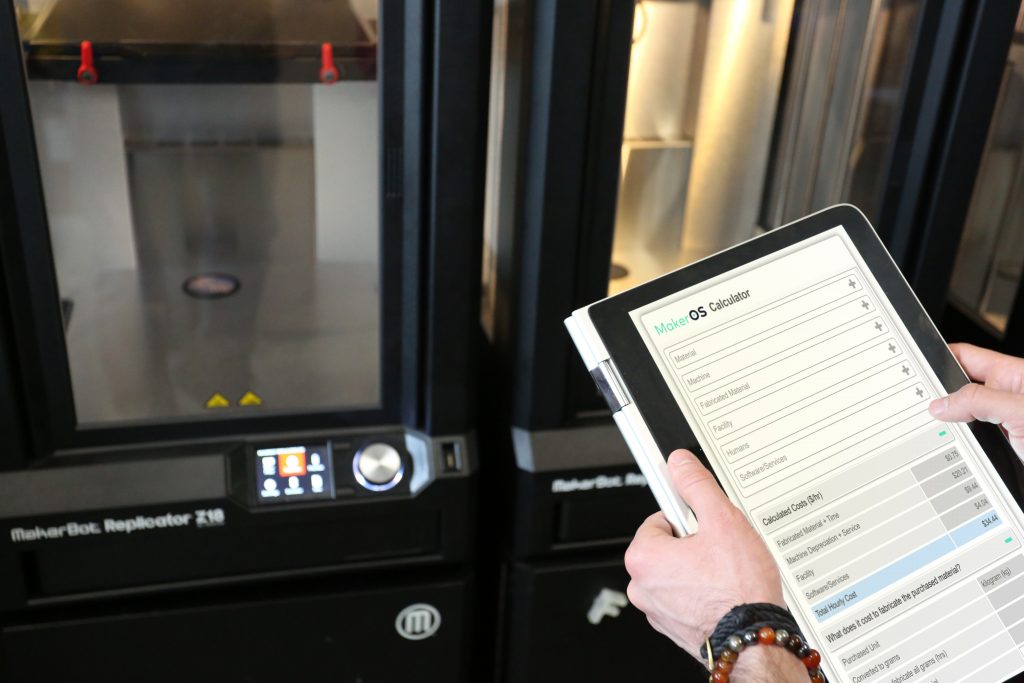By Mike Moceri, founder and CEO, MakerOS
If you’re running a 3D printing service, or a product development company where you’re quoting customers on digital fabrication services, there’s a good chance that you’re pricing wrong. Here’s how I know.
In the last five years, I’ve spoken to hundreds of 3D printing/Additive Manufacturing business owners about how they price their services and a vast majority of them undersell their services. The three primary reasons are either a combination or one of the following:
- They don’t take into account all of the ancillary components that go into running a business.
- They charge purely based on the volume of the CAD model not taking into account exponential price increases or decreases.
- Taking their slicer output of time to print and material usage too literal without physically measuring those parameters and taking into account #1 above.
Based on those hundreds of hours of conversation combined with years of industry experience, I’ve developed a holistic methodology on how to price for 3D printed parts and projects that accounts for all aspects of the business (human/machine time, machine depreciation, software, facility cost) the size of the job, and the unique attributes of the parts. I’ll share that methodology with you today, but first, a little more context on how I got here.

Back in 2013, while I was running a 3D printing service bureau, my team and I received an order from a Fortune 500 company to print them approximately 15,000 individual parts for a toy line. At the time, we were charging a little less than $1 per cubic centimeter printing in PLA and Nylon PA12, and that’s how we ended up pricing them for the job.
The project ended up being a very challenging one (that’s a whole different story that you should ask me about at some point) and after some time gaining more experience over the years, I realized that, considering how immensely large the job was, we should have priced about 70% more than what we originally quoted.
There’s a lot we didn’t factor for: the manual time it takes to prep, slice, validate, think through how to plate up and pull off parts; the software costs to execute all of those tasks; how long it actually took to print parts accounting for machine depreciation. It was quite a learning experience – in fact, it ultimately changed my life because I decided to do something about it, and I’m still doing it today.
I decided to start a company to help 3D printing and fabrication companies better manage projects, including how to price.
But first, I spoke with over 100 fabrication shops that offered 3D printing, CNC, and other similar services to see if they were experiencing the same issues I was. During a 5 month period, I personally interviewed and spoke with shop floor managers, business owners, and application engineers across the industry. Did other business owners experience the same problems? Were time and resources being wasted because of inadequate tools to facilitate projects? The answer was an overwhelming yes. So once I validated the problem, I began building the solution.
That solution is MakerOS.
MakerOS is a software platform for 3D printing and digital fabrication companies to better collaborate with their clients throughout the entire lifecycle of the project, from start to finish.
Our software features a suite of integrated tools that ensure project workflows are completed both optimally and efficiently. The tools include a “Public Autoquoter”, an online 3D viewer, a file sharing and messaging portal, an inventory manager, and a payment portal. All of those tools are connected and work with each other so that the process is streamlined and made incredibly easy for both the business and the client.
Our Autoquoter doesn’t just quote, the quote flows into the project workflow so that all relevant parties are set up for success. We like to tell our clients, “You’re not in the business of quoting, you’re in the business of executing projects for your customers.” That’s what our software enables you to do, and that attitude embodies the whole ethos of MakerOS.
Finally, back to our holistic methodology on how to price 3D printing projects that accounts for all aspects of the business. What you need to do is find a base understanding of your true underlying business costs and determine the price given what margin is most optimal for your business. I recommend accessing our latest on-demand webinar, “How to Optimally Price For Your 3D Printing Service Bureau in 2020” where I fully explain how to do this for FDM and SLS.
You can also play around with our 3D Printing Pricing Calculator that we developed to complement our new methodology.
Or you can simply reach out and contact us for a free consultation. We can talk about pricing, we can talk about MakerOS, or both. We’ve installed MakerOS with many different 3D fabrication shops all around the U.S. and have a tremendous amount of insight on the industry that we’re more than happy to talk about.
If you’re looking to ensure you’re pricing correctly, or how to better your 3D printing business, contact us to learn more. We’re looking forward to speaking with you.
About Mike Moceri
Mike has deep experience in manufacturing, design, and software. He’s personally quoted thousands of projects, produced hundreds of thousands of individual parts, and continually works with professional services around the world that offer Additive Manufacturing at MakerOS. In 2013, he co-founded the world’s first 3D printing retail service bureau in Chicago. In 2014 he founded Manulith, a 3D printing, and product design agency, where his clientele included Fortune 500 companies within the aerospace, automotive, and medical industries. Mike is also a mentor at Stanley+Techstars Additive Manufacturing Accelerator, a mentor at WeWork Labs in NYC, and formerly a mentor at TechTown Detroit. He’s previously been featured on MSN, Make Magazine, NBC, and the Encyclopedia Britannica. D-Business Magazine called him the “Face of 3D printing.”




